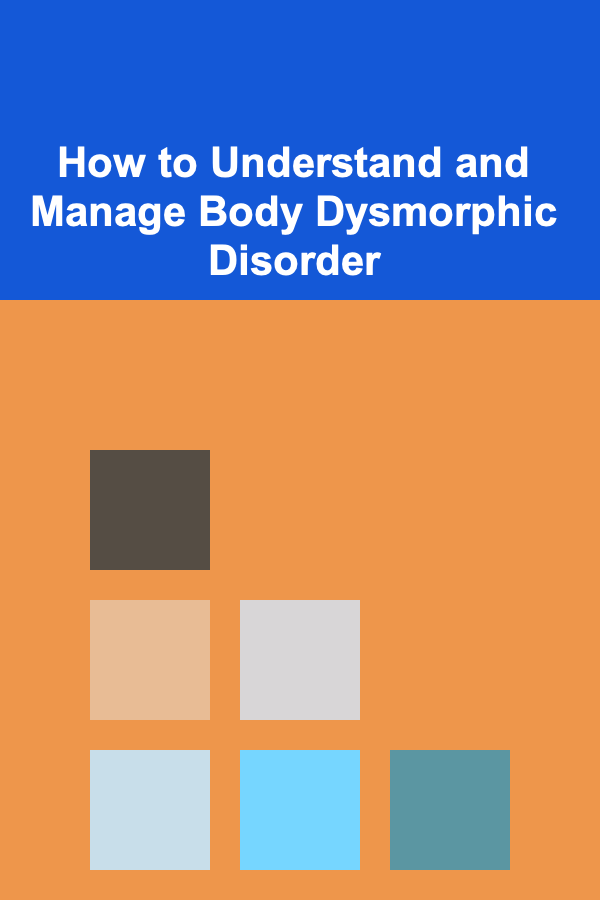
How to Understand and Manage Body Dysmorphic Disorder
ebook include PDF & Audio bundle (Micro Guide)
$12.99$10.99
Limited Time Offer! Order within the next:

Body Dysmorphic Disorder (BDD) is a complex and often misunderstood mental health condition that affects how individuals perceive their bodies. While it is common for people to feel dissatisfied with certain aspects of their appearance, BDD involves an overwhelming preoccupation with perceived flaws that are either minor or nonexistent. This condition can lead to significant emotional distress, social isolation, and even severe psychological consequences if not addressed properly. Understanding and managing BDD is crucial for improving quality of life and mental well-being.
What is Body Dysmorphic Disorder?
Body Dysmorphic Disorder is a mental health disorder characterized by an intense preoccupation with one or more perceived flaws or defects in physical appearance. These flaws, which are often unnoticeable to others, become the focal point of the individual's thoughts, causing severe distress and affecting their ability to function in daily life.
People with BDD may spend hours a day thinking about their appearance, obsessing over details such as skin imperfections, body shape, or facial features. This obsession often leads to repetitive behaviors such as mirror checking, excessive grooming, or seeking reassurance from others. In extreme cases, individuals may go to great lengths to "fix" these perceived flaws, including undergoing unnecessary cosmetic procedures or engaging in self-destructive behaviors.
Causes of Body Dysmorphic Disorder
The exact cause of Body Dysmorphic Disorder is not fully understood, but it is believed to be the result of a combination of genetic, biological, psychological, and environmental factors. Research suggests that individuals with a family history of mental health disorders, particularly obsessive-compulsive disorder (OCD) or other anxiety disorders, may be more susceptible to developing BDD.
Genetic and Biological Factors
Genetics may play a significant role in the development of BDD. Studies have shown that individuals with a close family member who has a mental health disorder, especially OCD, may have a higher risk of developing BDD. Additionally, imbalances in brain chemicals, particularly serotonin, have been implicated in several mental health conditions, including BDD.
Psychological and Environmental Factors
Psychological factors, such as low self-esteem, perfectionism, and a history of trauma or bullying, can contribute to the development of Body Dysmorphic Disorder. People who grow up in environments where appearance is highly valued or who experience constant societal pressure to meet beauty standards may be more vulnerable to developing this condition.
Furthermore, individuals who have been subjected to childhood abuse or bullying about their appearance may develop distorted views of their bodies as a way of coping with the emotional pain.
Symptoms of Body Dysmorphic Disorder
The symptoms of Body Dysmorphic Disorder can vary from person to person, but they often include:
- Preoccupation with Appearance: Individuals with BDD become intensely focused on a perceived flaw or defect in their appearance. This may involve minor skin imperfections, asymmetrical features, or body shape.
- Compulsive Behaviors: People with BDD may engage in repetitive behaviors such as mirror checking, excessive grooming, or comparing themselves to others. These behaviors are meant to reduce anxiety about their appearance, but they can exacerbate the problem over time.
- Avoidance of Social Situations: BDD can lead to extreme self-consciousness, which may cause individuals to avoid social situations, work, or school. They may fear being judged or ridiculed because of their perceived flaws.
- Excessive Concerns About Cosmetic Procedures: Some individuals with BDD become obsessed with undergoing cosmetic procedures, such as plastic surgery, to "fix" their perceived flaws. However, these procedures may not address the underlying psychological issue, and they may not lead to the desired results.
- Depression and Anxiety: People with BDD often experience feelings of depression, anxiety, and hopelessness. The constant worry about appearance can lead to a diminished sense of self-worth and social isolation.
- Distorted Body Image: Individuals with BDD have a distorted perception of their appearance, often seeing flaws that others do not notice. These flaws may appear exaggerated or non-existent.
Diagnosing Body Dysmorphic Disorder
Diagnosing Body Dysmorphic Disorder requires a comprehensive evaluation by a mental health professional, typically a psychologist or psychiatrist. The diagnosis is based on the presence of specific symptoms, including:
- A preoccupation with one or more perceived flaws in physical appearance.
- Engaging in repetitive behaviors or mental acts in response to the perceived flaws.
- Significant distress or impairment in social, occupational, or other areas of functioning due to the preoccupation with appearance.
It is important to note that BDD is often confused with other conditions, such as eating disorders or obsessive-compulsive disorder (OCD). A thorough assessment is necessary to differentiate between these disorders and ensure the proper diagnosis.
The Impact of Body Dysmorphic Disorder
BDD can have a profound impact on an individual's quality of life. The constant preoccupation with appearance can interfere with relationships, work, and overall well-being. Some of the consequences of untreated BDD include:
- Social Isolation: Individuals with BDD may avoid social interactions or become withdrawn due to their fear of being judged for their appearance. This isolation can exacerbate feelings of loneliness and depression.
- Relationship Problems: The obsessive focus on appearance can lead to strained relationships with family, friends, and romantic partners. People with BDD may seek constant reassurance or validation from others, which can be exhausting for those around them.
- Increased Risk of Self-Harm: In extreme cases, individuals with BDD may engage in self-destructive behaviors, such as skin picking, excessive exercise, or even self-harm, in an attempt to alter their appearance or cope with emotional pain.
- Poor Quality of Life: The distress caused by BDD can significantly reduce an individual's overall quality of life. The constant worry about appearance, combined with compulsive behaviors, can make it difficult to enjoy life or engage in meaningful activities.
- Cosmetic Surgery Addiction: Some people with BDD become obsessed with undergoing multiple cosmetic procedures, believing that each surgery will "fix" their appearance. However, these procedures often lead to dissatisfaction and a continued preoccupation with appearance, creating a cycle of surgery and self-esteem issues.
Managing and Treating Body Dysmorphic Disorder
Fortunately, Body Dysmorphic Disorder is treatable, and there are various approaches that can help individuals manage the condition and improve their quality of life. Treatment typically involves a combination of therapy, medication, and support from family and friends.
Cognitive Behavioral Therapy (CBT)
Cognitive Behavioral Therapy (CBT) is one of the most effective treatments for Body Dysmorphic Disorder. CBT helps individuals identify and challenge distorted thoughts and beliefs about their appearance, replacing them with more realistic and balanced perspectives. The therapy also focuses on breaking the cycle of compulsive behaviors, such as mirror checking and excessive grooming, by teaching healthier coping mechanisms.
In some cases, a specific form of CBT called Exposure and Response Prevention (ERP) may be used. ERP involves gradually exposing individuals to situations that trigger their appearance-related anxiety, while preventing them from engaging in compulsive behaviors. Over time, this helps reduce the need for reassurance and reduces the power of appearance-related thoughts.
Medication
Medications, particularly selective serotonin reuptake inhibitors (SSRIs), are sometimes prescribed to help manage the symptoms of BDD. SSRIs are commonly used to treat anxiety, depression, and obsessive-compulsive disorder (OCD), and they can help reduce the intensity of obsessive thoughts and compulsive behaviors associated with BDD.
Medications alone are usually not sufficient for treating BDD, but they can be a helpful adjunct to therapy. A healthcare provider can work with the individual to determine the appropriate medication and dosage.
Support Groups
Support groups can be an invaluable resource for individuals with Body Dysmorphic Disorder. Connecting with others who understand the challenges of BDD can reduce feelings of isolation and provide encouragement and advice. Many people find comfort in sharing their experiences and learning from others who have successfully managed the condition.
Family Support
Family members and loved ones can play a crucial role in the recovery process by offering emotional support and understanding. Educating family members about BDD can help them better understand the condition and provide compassionate support. It is essential for family members to avoid reinforcing compulsive behaviors, such as mirror checking or seeking constant reassurance, and to encourage the individual to engage in treatment.
Preventing Body Dysmorphic Disorder
While it is not always possible to prevent Body Dysmorphic Disorder, certain strategies may reduce the risk of developing the condition. These include:
- Promoting Healthy Body Image: Encouraging a healthy body image and self-acceptance from a young age can help reduce the risk of developing BDD. Fostering an environment that values inner qualities over appearance can have a positive impact on self-esteem.
- Reducing Exposure to Unrealistic Beauty Standards: The media often promotes unrealistic beauty standards, which can contribute to body dissatisfaction and the development of BDD. Reducing exposure to these images and promoting body diversity can help individuals develop a more balanced perspective on beauty.
- Encouraging Open Communication: Open communication about appearance-related concerns can help individuals express their feelings without fear of judgment. Talking about body image issues in a supportive environment can prevent them from escalating into more severe conditions like BDD.
Conclusion
Body Dysmorphic Disorder is a serious mental health condition that can significantly impact an individual's life. Understanding the causes, symptoms, and treatment options for BDD is crucial for those affected by the condition and for their loved ones. With the right combination of therapy, medication, and support, individuals with BDD can manage their symptoms, improve their body image, and lead fulfilling lives. Recognizing the importance of mental health and seeking help is the first step toward overcoming the challenges posed by Body Dysmorphic Disorder.
Reading More From Our Other Websites
- [Home Budget 101] How to Tackle the Financial Stress of Moving: A Budgeting for a Move Checklist
- [Organization Tip 101] How to Conduct Regular Digital Decluttering Sessions
- [Organization Tip 101] How to Make the Most of Your Tax Refund
- [Personal Care Tips 101] How to Care for Your Feet with Deodorizing Foot Spray and Other Products
- [Organization Tip 101] Why You Should Prioritize Organizing High-Traffic Areas
- [Home Family Activity 101] How to Make a Homemade Bowling Alley
- [Personal Finance Management 101] How to Reduce Monthly Expenses Without Sacrificing Comfort
- [Organization Tip 101] How to Create a DIY Craft Supply Organizer from Upcycled Materials
- [Home Security 101] How to Implement a Neighborhood Watch Program for Better Security
- [Organization Tip 101] How to Store Watches Safely to Avoid Damage

How to Break Down Large Projects into Paperwork Tasks
Read More
How to Coordinate Conference Registration: A Simple Checklist
Read More
How to Sanitize Your Kitchen After Cooking
Read More
How to Set Up a Cozy Indoor Picnic for Your Home Party
Read More
How to Use Color Grading to Enhance Photos
Read More
How to Make Flower Crowns with Foraged Flowers
Read MoreOther Products

How to Break Down Large Projects into Paperwork Tasks
Read More
How to Coordinate Conference Registration: A Simple Checklist
Read More
How to Sanitize Your Kitchen After Cooking
Read More
How to Set Up a Cozy Indoor Picnic for Your Home Party
Read More
How to Use Color Grading to Enhance Photos
Read More